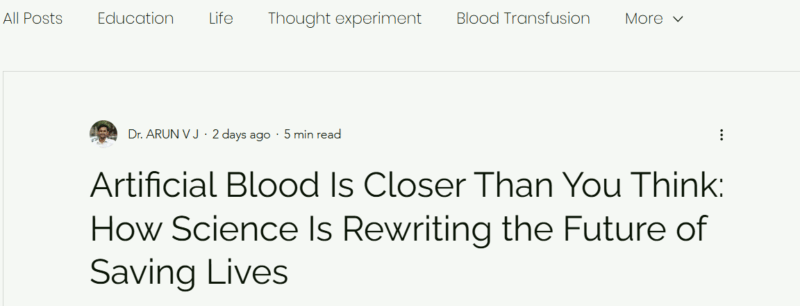
Arun V. J: Artificial Blood Is Closer Than You Think
Arun V J, Consultant in the Department of Transfusion Medicine at Malabar Medical College, shared a post on LInkedIn:
”Scientists Are Creating Blood in the Lab (Artificial Blood) — and It Might Save Millions
Every few seconds, somewhere in the world, someone needs blood.
And every year, thousands die waiting for it.
Even today, despite thousands of donation drives, the demand for blood far exceeds supply.
That’s when science decided to do what humans couldn’t — create blood in the lab.
Sounds like science fiction? It’s not.
It’s called Artificial Blood, and it’s one of the most fascinating frontiers in modern medicine.
Here’s how it works
- Artificial blood isn’t real blood.
- It’s a lab-made oxygen carrier — designed to do one job: deliver oxygen to your tissues when real blood isn’t available.
There are two major scientific approaches:
- Hemoglobin-Based Oxygen Carriers (HBOCs) — purified and modified hemoglobin (from human or bovine sources) that can circulate safely without red blood cells.
- Perfluorocarbon-Based Emulsions (PFCs) — synthetic molecules that physically dissolve and carry oxygen, much like soda holds carbon dioxide.
These substitutes are chemically sterile, don’t need cross-matching, and have shelf lives measured in months — not weeks.
Imagine this:
- A road accident victim gets an infusion that keeps them alive until real blood arrives.
- A soldier injured on a battlefield receives a blood substitute instantly.
- A rural hospital in India no longer faces panic due to blood shortages.
Artificial blood could make all this possible.
But — the science is still evolving.
Early trials showed side effects like vessel constriction and oxidative stress.
Now, researchers are using nanotechnology, stem cells, and even AI modeling to design safer, smarter versions.
The cost might be too high that it may not be accessible to everyone.
Some promising names to watch:
- HEMARINA – uses marine worm hemoglobin (Hemo2life)
- KaloCyte, Inc. aloCyte (USA) – developing ErythroMer, a synthetic red cell substitute
- FluorO2 Therapeutics – creating oxygen-rich emulsions for trauma care
The vision?
To build an emergency-ready, shelf-stable oxygen carrier that no longer depends on human donors.
As a doctor in transfusion medicine, I’ve seen what blood means — and what happens when it’s missing.
If science can bridge that gap, we’re looking at a future where no patient dies because a donor wasn’t available in time.
That’s not science fiction.
That’s science catching up with compassion.
Read the full article — in simple, clear language — on my blog:
What do you think?
Will artificial blood redefine healthcare — or will real blood donors always remain irreplaceable?”
Title: Artificial Blood Is Closer Than You Think: How Science Is Rewriting the Future of Saving Lives
Author: Arun V J

Stay updated with Hemostasis Today.
-
Dec 12, 2025, 14:478 Posts Not to Miss From the ASH 2025 – Marc Carrier
-
Dec 12, 2025, 10:17Alyssa George on Clinical and Economic Impact of a Eptacog Beta
-
Dec 12, 2025, 09:53Ivan Budnik Awarded AHA Postdoctoral Fellowship! Aiming to Improve DVT Long-term Outcomes
-
Dec 12, 2025, 09:34Giles Platford on Baby Big: Plasma-Derived Drug Against Infant Botulism
-
Dec 12, 2025, 09:22Matteo Foschi Presents The New Expert Guidance on Minor Ischemic Stroke
-
Dec 12, 2025, 07:00Umberto Pensato on Cancer and Stroke
-
Dec 12, 2025, 06:48Steve Tuplin on A New Era in Haemophilia A Care: Reflections from ASH25
-
Dec 12, 2025, 06:30Anirban Sen Gupta on Synthetic Platelets
-
Dec 12, 2025, 05:59Gaetan Duport: A New Legislation for Medicines in Europe
